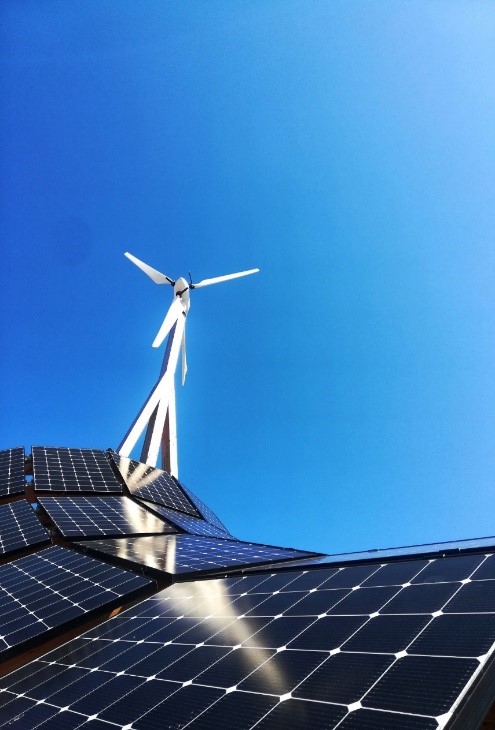The Bioproducts and Renewable Energy research group focus on applications of engineering in the fields of energy efficiency, renewable energy (solar, wind, biodiesel), agricultural and safety health and environment (SHE).
D) Wind and Solar
 Introduction:
Introduction:
Electricity is a vital part of current way of life and it is important to the Malaysia economy and Revolusi Perindustrian Keempat (IR 4.0). Malaysian use electricity for cooking, lighting, cooling, refrigeration, computers, electronics, machinery, and public transportation systems. One of the known renewable energy is generated from wind using horizontal axis wind turbine (HAWT). Nevertheless, Malaysia is one of the countries that has natural low wind speed average 2 m/s, where optimum conditions for harvesting wind energy requires 15 m/s wind speed. Thus, to overcome the conundrum, a pioneering solar updraft tower with magnus wind turbine (MWT) prototype for Malaysia energy security is proposed in this research. Solar updraft tower can provide a very simple method for renewable electricity generation, with a constant and reliable output. Due to the Malaysia low wind speed, HAWT significantly loss its power performance. However, Malaysia tropical weather can be exploit using solar updraft tower with MWT. Solar updraft tower does not require wind speed to generate electricity. Instead, its use temperature different to create updraft. Furthermore, the advantage of MWT is that it can produce higher electricity output compare to the HAWT under same condition. The objective of the study is to investigate the performance of solar updraft tower with MWT under Malaysia weather condition. The methods comprise of numerical analysis, computational analysis, modelling, fabrication and field test experiment at UPMKB. The new solar updraft design will be utilizing magnus effect for harvesting wind energy. The research plan is to collect data of power performance input and output of the prototype with wind speed range of 6 to 10 m/s and make comparison with HAWT. The expected outcome is a patentable prototype that can generate reliable electricity output and upscale size prototype for future research.
 Pictures:
Pictures:

Solar and wind
 Publication
Publication
 Journals
Journals
- Marzuki, O.F., Rafie, A.S.M., Romli, F.I., and Ahmad, K.A. (2018) Magnus Wind Turbine: The Effect of Sandpaper Surface Roughness on Cylinder Blades. Acta Mechanica.
- Mgaidi, A.M., Rafie, A.S.M., Ahmad, K.A., Zahari, R., Abdul Hamid M.F., and Marzuki, O.F. (2018) Numerical and Experimental Analyses of the Flow Around a Rotating Circular Cylinder at Subcritical Regime of Reynolds Number using K-Ε and K-Ω-SST Turbulent Models. ARPN J. Eng. Appl. Sci., 13
An experimental investigation was conducted of a rotating circular cylinder immersed in a free-stream flow. The study was motivated by some apparent discrepancies between experimental and numerical studies of the fluid flow, and the general lack of experimental data, particularly in the subcritical Reynolds number regime. Of interest was the direction and origin of the lift force generated on the cylinder, which has been the subject of contradictory results in the literature, and for which measurements have rarely been reported. The circular cylinder was tested at 3 different free stream speeds 11, 13, and 15 m /s. The dimensionless speed ratio and Reynolds number (Re) also ranged from ô°€ = 0.6 - 1.1, and 1.50E05 - 2.14E05, respectively. Verification of the experimental was achieved through using of computational fluid dynamics (CFD) code ANSYS FLUENT15 to simulate a two-dimensional flow of a viscous incompressible fluid past a rotating cylinder subject to a circular motion. Indeed, grid independency test (GIT) as well as the effect of domain size, have been conducted and a suitable agreement was found based on comparison of the CFD and experimental fluid dynamics (EFD) results, where a good agreement with experimental data in global quantities is predicted through generating of a fine mesh enhanced with choosing of y+ value less than 1. In the next step, the attention has been focused on comparing between the simulation results of k-ε, and k-ω -SST viscous models, to determine the most compatible model in using CFD code with the EFD results in certain mentioned condition. Generally, simulation results of each of mentioned two equations turbulent models show similar patterns as compared to EFD. A comparison of the results showed that, the margin of error in lift force coefficient was arranged from 39 - 60 % and 10 - 14% for k-ε, and k-ω -SST, respectively, which surprises the shear stress transport turbulent model as more compatible viscous model. The correspondence is seen to be excellent for analyzing the characteristic of fluid flow around the rotating objects in subcritical regime of Re.
- Eun, L.C, Rafie, A.S.M., Wiriadidjaja, S., and Marzuki, O.F. (2018) An Overview of Passive and Active Drag Reduction Methods for Bluff Body of Road Vehicles. International Journal of Engineering & Technology
- O.F. Marzuki, M. Mgaidi, A. S. Mohd Rafie, K. A. Ahmad, R. Zahari (2019) A Review Study on Magnus Wind Turbine for Accessing the Aerodynamic Performance. World Journal of Engineering Research and Technology 5 (3)
Wind energy became an increasingly important and widespread renewable energy source in the last decades, while it is significant technical development has led to a wide variety with more effectiveness. Magnus wind turbine (MWT) represents one of main application of horizontal wind turbines that are viable in low wind speed regimes and also suitable for the urban areas. Numerous numerical and experimental investigations have been performed to analyse and improve the design and performance of MWT, However, most of these studies revolved around aerodynamic performance of magnus turbine. This paper reviews the application of Magnus effect devices and concepts especially in wind energy that have been investigated by various researchers and concludes with discussions on future challenges in their application.
 For more further enquiries:
For more further enquiries:
Dr. Omar Faruqi Bin Marzuki
Senior Lecturer
Department of Science and Technology
Faculty of Humanities, Management and Science
Tel: +6086 855847
Email: omar_faruqi@upm.edu.my
Updated:: 07/09/2020 [lanz]
MEDIA SHARING











 Introduction:
Introduction: Pictures:
Pictures:
 Publication
Publication  Journals
Journals For more further enquiries:
For more further enquiries:


















